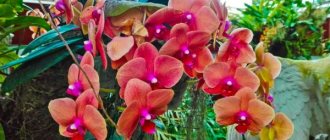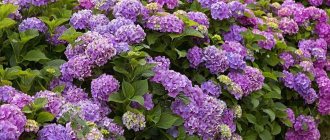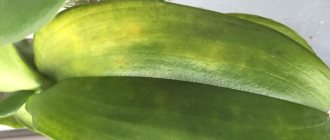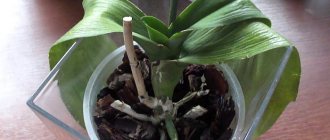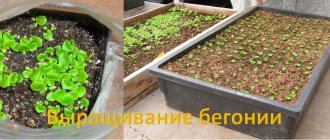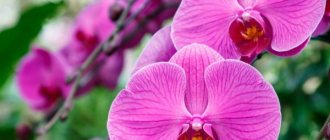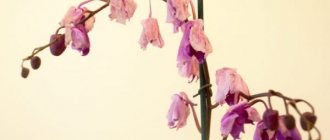Where can transparent droplets appear?
Viscous transparent droplets can form on different parts of the plant:
- on leaves;
- flower shoot;
- Bulbach.
On the leaves
The appearance of drops on the underside of a leaf is not always a cause for concern. This may be a natural process of transpiration. The occurrence of infection or parasites is indicated by the simultaneous presence of plaque or spots. There are also parasitic insects that leave a shiny sticky trail (aphids, mealyworms, copperheads). Still, it’s worth making sure the tropical flower is healthy and preventing infection.
On the peduncle
Sticky moisture on a flower shoot signals improper care and an unsuitable microclimate for the plant. Here the drops are more difficult to notice; they look like water that accidentally fell on the peduncle. However, you should not miss this sign. Errors in care weaken the orchid’s immunity and lead to the development of diseases. If drops are detected, excessive watering and high humidity should be immediately avoided.
On the bulbs
The body of Phalaenopsis is called bulbs. The appearance of sweet drops on these parts of the plant may indicate improper watering or the presence of pests. Here it is immediately clear that the orchid is in danger. The owner should immediately begin taking measures to save the flower.
Current questions about guttation in orchids
Question No. 1. On my phalaenopsis, drops of syrup appear only on the peduncle, but not on the leaves. Is this also guttation?
This is the secretion of extra-floral nectar that orchids also exhibit when they sense the change of season. This nectar is sometimes called “honeydew” or “honeydew” and serves to further attract pollinators. Bees collect these drops, and beekeepers even have the term “honeydew honey.” In orchids, honeydew is secreted in the peduncle area. You can remove it with a slightly damp cotton swab, but this is not a necessary procedure.
Reasons for the appearance of sticky drops on an orchid
Viscous nectar is released on different parts of the plant as a result of exposure to unfavorable factors:
- high humidity;
- natural phenomena of transpiration;
- diseases;
- pests.
High humidity
When overwatered, the plant releases excess moisture through the leaves and stems. If the grower does not normalize the care of the orchid in time, it begins to rot. The watering regime should provide the Phalaenopsis root system with time to contact oxygen. That is, the roots should not be constantly in water.
Important! The most unfavorable is excessive watering in combination with low temperatures and bright light.
To avoid high humidity, you must follow the following rules:
- Check the soil moisture not from above, but inside the layer. Water only when the soil is dry.
- If the rhizome is in a transparent plastic pot, then condensation will form on its walls. The orchid should be watered after it disappears.
- The average frequency of watering in summer is once a week, in winter – once every 2 weeks.
If the housewife is not sure about the need for watering, then it is better to postpone it for a day.
Extrafloral nectar
The phenomenon of secretion of extrafloral nectar is called transpiration. In its natural habitat, the orchid secretes a sweet sap to attract pollinating insects. Domestic Phalaenopsis retained this function.
Extrafloral nectar will not harm the crop. Drops from leaves and stems should not be removed. If, however, the cause is the presence of pests, then the overall picture of the disease will not be clear.
Pests
The orchid may react with sticky drops on all parts of the plant to the appearance of pests. The protective functions of the juice are that the insect is immobilized in a viscous substance and cannot cause harm. Another option is that sticky mildew attracts beneficial insects, which repel harmful ones or feed on them.
In addition, parasitic insects themselves can leave a shiny sticky trail. Their presence is easy to notice with the naked eye on the reverse side of the sheet. Pests that feed on the juices of the plant lead to its death.
Diseases
Powdery mildew disease is accompanied by the appearance of sticky drops and a white coating. This is a fungal infection. But later another fungus may join. In this case, the white spots become dark, and the places where they are located become dry.
Interesting! The cause of the disease is inappropriate growing conditions and systematic excessive watering of Phalaenopsis. All this is a favorable environment for the development of fusarium and other fungal infections.
Powdery mildew pathogens interfere with the normal course of photosynthesis. In this regard, the flower stops developing, and the leaves are often deformed.
Reasons for the formation of droplets on the leaves, trunk and peduncle
Why do sticky drops appear? There are several factors that provoke their appearance - from completely harmless to extremely dangerous:
Mealybug infestation . Viscous droplets over the entire surface of the leaf and at its tips may be the first symptom of damage by this parasite. Following the appearance of drops, the plant becomes covered with a white or grayish coating of colonies of harmful insects. They multiply rapidly and poison the flower with the products of their vital activity, leading to the death of the orchid.
- Other diseases : the release of a sticky substance may also indicate that the flower is suffering from attacks by mites, worms or scale insects.
- Attracting insects for pollination : in this case, the drops are just sweet nectar that attracts creatures that can pollinate the flower in nature, such as moths, wasps, bees and even spiders.
At home, this harmless process can be dangerous, since the sweet liquid will attract not natural pollinators, but harmful ants and aphids. - Method of self-defense : the plant needs nectar to distract the attention of some pests from flowers and buds - they die in viscous droplets on the leaves of the orchid before reaching the inflorescence.
Honeydew is attractive to aphids, after which ants come to the plant, driving away leaf cutters that are dangerous to orchids. However, such a mechanism is fraught with excessive reproduction of aphids, which suck out the nutritious juices from the orchid. - Abundant feeding of the plant : an orchid oversaturated with artificial nutritional components gets rid of excess sucrose, actively producing sweet dew on the surface.
- Irregular watering : sudden changes in the volume of moisture received by the plant, accumulation of liquid in the pan or substrate, improperly formed drainage also provoke the appearance of sticky droplets.
We invite you to watch a video about why drops appear on an orchid:
Why does sweet juice appear?
Sticky drops are a natural reaction of an orchid to unfavorable conditions. These include any deviations in plant care, as well as damage from insects and diseases. Together with the sweet juice, the leaves and shoots release excess moisture or nutrients. Phalaenopsis also reacts to the appearance of honeydews that are dangerous to it.
If the plant continues to bloom actively and looks healthy, then the sweet sap may have come from transpiration. Orchids need this in natural conditions. The sap has a subtle aroma that attracts pollinators.
Ways to combat diseases and pests
If sticky droplets appear on the orchid, you must first inspect the plant, check the soil for the absence or presence of overflow, and remove the pot from the rays of the bright sun. If the care is correct, but the problem does not disappear, then the cause is illness or infestation with indoor pests. You will have to arm yourself with purchased drugs to cure the flower, eliminate scale insects and mites.
Advice: Such products as “Alirin-B”, “Zircon”, “Aktara” or “Aktellik” have proven themselves well.
However, first you need to resort to home treatment methods: reducing watering in the cold season, humidifying the air by spraying around the pot, wiping the leaves with soapy water at room temperature. Often such methods help get rid of stickiness and eliminate unwanted symptoms.
Getting rid of pests:
- once every two weeks you can replace watering by soaking the orchid in a basin filled with water with the addition of 2 Alirina-B tablets;
- When a scale insect appears, you should first wipe the above-ground parts of the plant with soapy water, then spray it with an intoxicant solution from a spray bottle;
- if affected by a mealybug, you need to water the orchid with water at a temperature of at least 40 degrees (a warm shower will do) and treat it with preparations containing oil;
- help fight worms and mites by removing affected leaves, tops, replanting, washing the surfaces of the pot and window sill;
- home remedies for pest control include adhesive tape against flies, spraying with horsetail tincture, crushed garlic with vegetable oil, and a solution of medical alcohol with soapy water;
- if there are few pests on the flower, such preparations for spraying and watering as Fozalon, Phosfamide, Nurell-D, Promanal AF Neu, Bi 58 are suitable.
In order not to lead to serious treatment of the orchid, you should be careful about temperature changes, watering, and air humidification. You should not place the pot on a lit windowsill in the summer, and neglect the rules of care and feeding.
Prevention and inspection for the absence of harmful insects are of great importance. If sticky drops appear immediately after watering and only once, you should not pay attention to this phenomenon.
What to do?
The measures that need to be taken when sticky drops appear depend on the cause of their occurrence. If there is excess moisture, the plant is slightly shaded. If necessary, replace the substrate. If the watering regime is systematically violated, a fungal infection may develop. In this case, droplets from the leaves are carefully removed with a soft cloth.
Attention! If there is nothing wrong with the flower and the sweet juice is extrafloral nectar, then nothing needs to be done. But a plant infected or damaged by insects is treated with medications.
Diagnostics
Pest damage to an orchid is diagnosed upon inspection. Insects are easy to spot on the back of the leaf. Also be sure to check the soil. To do this, the flower pot is immersed in water overnight, and in the morning the floating insects are discovered. Infectious diseases are identified by characteristic powdery white or brown spots on all parts of the plant.
Treatment methods
When insects are found, they are collected from the flower by hand. Then the orchid is washed under a weak stream of warm water. After the flower has dried, it is treated with the following preparations:
- Fitosporin;
- Actellicom;
- Aktara.
Removal of powdery mildew should begin immediately after its detection. The orchid is isolated from other plants, and the white coating is removed with a cotton swab dipped in a solution of laundry soap. Damaged areas are cut off and then treated with fungicides. Skor and Topsin-M are suitable for these purposes.
Attention! Treatment should begin as early as possible. Infectious diseases and insects can lead to the death of a flower in a matter of days.
To prevent the disease from developing in other indoor flowers, they are sprayed with Fitosporin.
Possible pests
Peduncle of an orchid: causes of diseases and methods of combating them
The cause of sticky drops on orchid leaves may be external manifestations of pests:
- Mealybug. It can be confused with the scale insect. It can appear not only on the plant, but also nearby, on the soil. Larvae and adults bite into leaves and stems and suck out the juice. They leave behind sticky marks. Toxic enzymes secreted by scale insects enter the vessels of plants. The plant weakens and may die.
- Aphid. You can recognize it by its curled sticky leaf and wilted flower stalks. Aphids suck the juice from the leaves, causing them to gradually die. If measures are not taken, secondary infection with sooty fungus may occur. It is better to destroy the pest with insecticidal preparations, but before doing this, wash the shoots with a solution of soap and tobacco.
- A miniature white butterfly - whitefly. She gnaws through the top layer of orchid tissue and sucks out the juice. It leaves behind transparent nectar and yellow stains. Many gardeners save orchids by hanging flypaper around them to prevent flies, but if you don’t have time, the butterfly that has settled on the plant lays eggs, and the fight against it becomes more difficult. Any insecticide will help against whiteflies. After spraying, the plant is placed under a film so that not only the adults, but also the larvae of the pest die.
- Shield. The pest reproduces very quickly; females store their eggs under their shell. The hatched larvae are able to move. They crawl along the shoots, looking for a place where they can attach with their proboscis and remain until they reach adulthood and lay eggs. The food of the scale insect is the sweet juice of phalaenopsis. If you water the soil in a flowerpot with an enteric-contact insecticide. The scale insect will suck out the poisoned juice, which will provoke its death.
Orchid pests
Preventive measures
Prevention of the appearance of sticky drops is the same as for other Phalaenopsis problems. Such measures include:
- proper watering;
- compliance with microclimate conditions;
- timely treatment with vitamin preparations and fungicides;
- periodic inspection of the plant.
Important! The drugs Fitosporin, Actellik, Aktara can also be used for the prevention of diseases. Their use prevents the appearance of parasitic insects.
Special vitamin cocktails, which include B vitamins and succinic acid, help strengthen the immunity of Phalaenopsis. It is useful to use such fertilizers to prevent flower diseases.
5 / 5 ( 1 voice )
How to solve the problem and save the flower?
An external inspection of the plant is carried out in order to identify the presence of other problems that pose a hidden threat. First of all, the condition of the green rosette is examined, paying special attention to the inner leaf plate. Next, check the surface of the substrate and the tray of the pot for moisture accumulation.
In the absence of negative factors, there is no cause for concern. It is enough to remove sticky droplets from the orchid with a cotton pad dipped in cold boiled water. The purpose of this procedure is to remove sweet nectar that attracts household pests. It is very effective to periodically take a hot shower.
The detection of spots on the leaves, in addition to sweet traces, is a signal of serious violations in the rules of flower care. In such a situation it is necessary:
- change the location of the plant in order to reduce the brightness of the lighting;
- increase the ambient temperature, creating a more favorable microclimate;
- reduce watering, dry the above-ground part of the substrate, and prevent moisture from accumulating in the base of the pot.
The problem is aggravated by excessive fertilizing, carried out not in accordance with the life cycle of the orchid. To save it, the substrate must be completely replaced to prevent rotting of the roots and leaf rosette. Upon careful inspection of the flower, it is easy to notice harmful insects even with the naked eye. More often they are found on the inside of leaves or in sweet nectar clots.
Powdery mildew disease manifests itself in an abundant secretion of sticky droplets, which quickly turn into a white coating. Later, gray and even black spots appear.
A plant affected by harmful insects or diseases must be urgently quarantined, separated from healthy neighbors.
If the source of infection is small, the above-ground part of the orchid is cleaned with diluted alcohol, a solution of laundry soap or an oily tincture of garlic, but the most effective methods of treatment involve the use of special chemicals.
Pest and disease control products
Specialized stores offer a wide range of insecticidal preparations that successfully rid tropical beauties of harmful insects. Complete cure occurs with regular treatment of the leaf rosette and substrate every ten days. The duration of treatment is more than two months. The line of special chemicals consists of the following types:
- Alirin B;
- Fitoverm;
- Zircon;
- Aktara;
- Actellik.
It is most effective to carry out treatment by immersing the flower in a solution with insecticides and spraying the leaf rosette with it.
When using chemicals, you should strictly follow the instructions for use so as not to harm your own health and the orchid. Powdery mildew disease is treated with fungicides containing copper and the antifungal drug Fitosporin. The leaf rosette is treated according to the recommendations until the white coating completely disappears.
Causes
If you find such droplets on your indoor flower, you need to quickly determine the reason for their appearance. In one case, immediate measures will be required to save the plant; in the other, this is a natural process.
Sticky drops can appear for various reasons:
- A natural process , flower nectar attracts pollinating insects or, conversely, serves as a trap for insect pests.
- Excessive watering - accumulated moisture oversaturates the flower, and it gets rid of it by evaporation through the leaves. If you add bright lighting and low temperature to improper watering, then this will be the answer to the problem.
- Damage by harmful insects - with poor immunity, the plant can be attacked by pests such as aphids, scale insects, mites or scale insects. They feed on plant sap and the sticky layer is a kind of signal for help.
- Disease damage - sticky drops indicate an infectious disease such as powdery mildew. Another sign of the disease is that a white coating or black fungal spores are noticeable on the leaves of phalaenopsis.
- Excessive feeding - with excessive use of fertilizing, the exotic flower's metabolism increases and it tries to get rid of excess sugars caused by the use of fertilizers, secreting nectar in the form of a sticky layer on the leaves.
Content errors causing the problem
When overwatered, the flower becomes covered with sticky drops, similar to dew. In this way, the flower tries to remove excess moisture that has entered its cells. If improper watering is systematic, the flower will not be able to remove excess liquid and will simply begin to rot.
Often the orchid “cries” due to excessive watering.
To prevent the flower from dying, it is necessary to organize the correct watering regime so that the root system can breathe oxygen between them. She needs it for the process of photosynthesis.
What is prevention?
A healthy, abundantly blooming orchid is the pride of every gardener. Compliance with the rules of care and feeding is the main condition for the successful cultivation of a flower. It is important to maintain optimal temperature and humidity to create a favorable microclimate, monitor the level of illumination of the plant, avoiding excess sunlight on long summer days.
Regular inspections of the orchid allow you to early detect that sticky drops have appeared, promptly make adjustments to care, and identify damage from harmful insects or the first signs of disease. Prompt treatment will protect the plant from severe consequences.
What are these drops and what do they look like: description and photo
It happens that drops appear on the leaves of phalaenopsis that look like dew, they feel sticky to the touch and taste sweet. They can be of different sizes and located in different parts of the flower. If you look closely at them, you can see the sugary structure.
Reference! This phenomenon has a scientific name - transpiration.
In the photo you can see what the drops look like on the leaves of the plant.
Red leaves
Sometimes flower growers are faced with a problem such as reddening of the leaves of an orchid, believing that it is some kind of disease or the plant has been exposed to pests. But in fact, the reason for this change in leaf color is the plant receiving sun or heat burns.
This is a fairly common problem that can arise from direct sunlight hitting the plant in spring and summer, or in winter when the orchid overheats from being near the battery.
If this happens, then this is a signal that something needs to be done, for example, change the location of the flower. In spring and summer, it is better to keep the orchid on windowsills on the east or west side. In winter, you can place it in southern areas, but preferably away from the battery. Damaged areas cannot be restored; they can be left as is or these scorched leaves can be cut off. In conclusion, it can be noted that this condition of the leaves is not considered a disease, so it cannot be treated.

